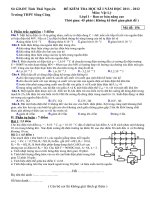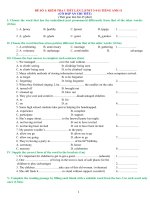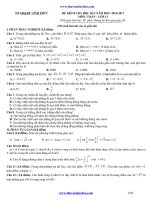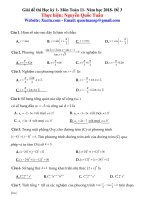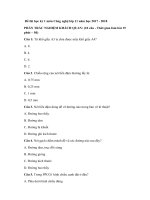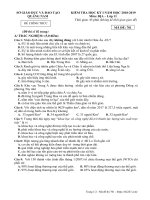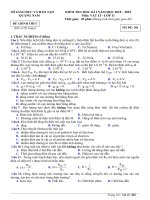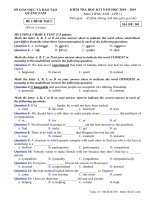De thi hoc ky 1 global success 11
Bạn đang xem bản rút gọn của tài liệu. Xem và tải ngay bản đầy đủ của tài liệu tại đây (990.3 KB, 58 trang )
ĐỀ THI HỌC KÌ 1 – ĐỀ SỐ 1
MƠN: TIẾNG ANH 11 GLOBAL SUCCESS
BIÊN SOẠN: BAN CHUYÊN MÔN LOIGIAIHAY.COM
Exercise1.ChooseA,B,CorDtoindicatethewordwhoseunderlinedpartdiffersfromtheotherthreein
pronunciation in each of the following questions.
1.A.combine
B.power
C.provide
D.method
2.A.suggest
B.goal
C.program
D.organize
Exercise2.ChooseA,B,CorDtoindicatethewordthatdiffersfromtheotherthreeinthepositionof the primary
stress in each of the following questions.
3.A.regular
B.energy
C.position
D.diagram
4.A.sustainable
B.residential
C.renewable
D.available
Exercise3. ChooseA, B,C or D to indicatethecorrect answer toeach of thefollowingquestions.
5. After he had finished his English course, he
A.goes
B.went
C.hasgone
6. Sleep, rest and relaxation can
A. slowdown
B.speedup
toEngland to continue hisstudy.
D.wasgoing
theageingprocess.
C. turnoff
D.turnon
7. The major factor
thegenerationgapislackofcommunicationbetweenparentsandtheirchildren.
A.causing
8. Those audiences
A.haveto
B.resulting
C.leading
showtheirticketsbeforeenteringtheconcerthall.
B.must
C. oughtto
9. To decide the winner of thecompetition, the examiners
A.taste
10. City
A.dwellers
D.making
B.tasted
C.aretasting
D.d o n ' t h a v e to
candidates'dishesnow.
D.wastasting
willstopusing theircars inurbanareas.
B.governments
C.authorities
D.researchers
11. Smokersgenerallydoknowthatsmokingisextremelyharmful,butit’sjustthattheycan’thelp it.
A.doing
B. todo
C.do
D.havingdone
12. Singapore has made a huge
A.decision
B.effort
13. A large amount of carbon dioxide
A.emissions
B.carbonfootprint
toscholarshipsforASEAN’sstudents.
C.contribution
D.arrangement
arereleased into the atmosphereby burning fossilfuels.
C.emit
D.greenhousegas
14. As a student, I think I should study more and be more responsible for making contribution
.preserving our environment better.
A.on
B.of
C.from
D.to
Exercise4. ChooseA, B,C or D to indicatethecorrect responsetoeachof thefollowingexchanges.
15. Liz:“Guesswhat? Myfirstnovelhasjustbeenpublished.” -Andrew:“
A. It’smypleasure.
B.Congratulations!
C.Betterlucknexttime!
D.It’sverykindofyou.
”
16. Mike:“Can I feed the gorilla, Mrs Smith?” - Mrs Smith: “
.Thesignsays‘Nofeedingtheanimals’.”
A. Ofcourseyoucan
B.Idon’t think itworks
C.I’msureaboutthat
D.I’mafraidnot
Exercise5.Complete thefollowingsentences withthecorrect formsofthewordsincapitals.
17. The book opens with an
(EXPLAIN)
of why some food are not good for health.
18. Farming contributes more than 30 percent of the total greenhouse gas
.
(EMIT)
19. Gen Zers are very
andabletoexperimentwithsocialplatformstosuittheirneeds.
(CREATE)
20. In the future, cities will only use
sourcesofenergysuchaswindandsolar
power. (RENEW)
Exercise6.Readthefollowingtextandchoosethebestanswerto fillintheblanks.
Glaciers aremelting, sea levels are rising, cloud forests are dying. Morealarmingly, wildlifeis scrambling to
keep(21). It’sbecomingclearthathumanshavecausedmostofthepastcentury’swarmingby(22)h e a t - t r a p p i n g
gases
as
we
gases,
their
power
levels
our
are
modern
higher
lives.
now
than
Called
in
the
greenhouse
last
650,000
years.
Wecalltheresultglobalwarming,butitiscausingasetofchangestotheEarth’sclimate,orlong-termweather
patterns,thatvariesfromplacetoplace.AstheEarthspinseachday,thenewheatswirlswithit,(23)u p
m o i s t u r e overtheoceans,risinghere,settlingthere.It’schangingtherhythmsofclimatethatalllivingthings
have come to rely upon.
Whatwillwe dotoslowthiswarming?Howwillwe cope(24)t h e changeswe’vealreadysetinto(25)
?
While
face
of
farms
we
the
and
struggle
Earth
as
to
we
snow-capped
figure
know
it
all
it-coasts,
out,
the
forests,
mountains-hangs
in
the
balance.
()
21.A.space
B.pace
C.rhythms
D.step
22.A.relieving
B.publishing
C.releasing
D.unraveling
23.A.pick
B.topick
C.picking
D.picks
24.A.with
B.on
C.at
D.to
25.A.fluctuation
B.direction
C.movement
Exercise7. Readthepassage andthebestanswerto eachof thefollowing.
D.motion
The22ndSoutheast Asian Gameswereheld in Vietnam from the5thto13thDecember,2003. Although it was the first
time Vietnam hosted such a big sports event, the Games were a great success. The Games really became a
festival that impressed sports enthusiasts with its spirit: solidarity, co-operation for peace anddevelopment.
Athletes from 11 participating countries competed in 32 sports, and 444 gold medals were won. Someteams
suchastabletennis,badminton,karate,volleyball,basketballandwrestlingwerecomposedoftopcompetitors
intheregion.ManyGamesrecordswereclosetointernationallevels.Vietnamwon158goldmedalstofinish
atthetopoftheSoutheastAsianGamesmedalstandings.Thailandrankedsecondwith90golds,andIndonesia was thirdwith only 55
golds. Singaporeand Vietnam werethe two nations which had participants whowere presented with the Most
Outstanding Athlete titles in the Swimming and Shooting events. The Vietnamese Women's Football team
successfully defended the SEA Gamestitle. Vietnam and Thailand played in the Men's Football Final. The
Thai Team won the gold medal. In other sports such as karate, athletics, bodybuilding and wushu, the young
and energetic Vietnamese athletes performed excellently and won a lot of gold medals.
Vietnam's first place finish was not surprising. Firstly, to prepare for the 22 ndSEA Games, Vietnam carried out
anintensiveprogramme for its athletes, which included training in facilities, both home and
abroaD.Secondly,withthestrongsupportoftheircountrymen,theVietnameseathletescompetedinhighspirits.The
country's success has proved that Vietnam can organise sporting events on an international level. A plan has
been proposed for Vietnam to host the Asia Sports Games at some point in the future.
26. It can be inferred from the passagethat
.
A. Vietnamcanorganise sportingeventsbetterthanothercountries
B. Vietnamhadalreadyplanned forthenextSeaGamesinthefuture
C. Vietnamprepared itsathletes well forthe 22ndSEAGames
D. Vietnamprotectedits firstplacein SEAGamescompetition
27. Theword "title" in paragraph 2 is closest in meaning to
A.power
B.label
C.headline
.
D.Trophy
28. Accordingto thepassage, what is NOT trueabout the22ndSoutheast AsianGames?
A. Therewere11countriesparticipatingin.
B. Manyathleteshadbrokentheworldrecords.
C. IndonesiarankedhigherthanSingapore.
D. VietnameseWomen's Footballteamwongoldmedal.
29. Theword"intensive”inparagraph3hasOPPOSITEmeaningto
A.delicate
B.flexible
C.sensitive
30. Whatisthewriter'smain purposeinwritingthispassage?
A. Toexplain the reasons why22ndSeaGames was organisedinVietnam.
B. Toexpressthewriter'slove andhowmuchheisproudofthecountry'ssuccess.
.
D.vigorous
C. Tointroducetop competitorsin theregionandtheirranking intheGames.
D. ToshowVietnamese'sabilityinorganisinginternationalsportingevents.
Exercise8.Completethesentenceswithoutchangingthemeaning.
31. Iprefer going outfor amealto staying athome.
=>I’drather
.
32. There’snoneedforyou todrivevery fast.(usingModals)
=> You don’t
.
33. Itisbetter foryoutotalktoyourparentsaboutyourproblem.
=> You
.
34. Whendid youbegin todo researchon lungcancer?
=> How long
.
35. Whenitisseen fromtheoutside,thebuilding looksamess, butitislovelyinside.
=>
.
Exercise9.Listen anddecide ifthefollowing questionsare TrueorFalse.
36. The miniskirt was invented in the
.
37. Thespeakersboththinkthatthe
wasoneofthegreatestinventionsinthefashionworld.
38. Bell-bottoms could have legs opening up to
39. A trend in the
40. Rachel agrees that,
centimetres.
was"powerdressing." Womenworeshoulderpads tolookpowerful.
soundsreallycool.
------------------------THEEND------------------------
HƯỚNGDẪNGIẢI
Thựchiện:Ban chuyênmônLoigiaihay.com
1.B
2.A
3.C
4.B
5.B
6.A
7.A
8.A
9.C
10.A
11.A
12.C
13.B
14.A
15.D
16.D
17.explanation
18.emissions
19.creative
20.renewable
21.B
22.C
23.C
24.A
25.D
26.C
27.D
28.B
29.A
30.A
36.1960s
37.miniskirt
38.66
39.1980s
40.powerdressing
31. I'drathergooutfora mealthanstayathome.
32. Youdon’t haveto driveveryfast.
33. Youshould talkto yourparentsabout yourproblem
34. Howlong haveyou doneresearch on lungcancer?
35. Seenfrom theoutside, the buildinglooks amess, but itis lovelyinside.
HƯỚNGDẪNGIẢICHITIẾT
1. B
Kiếnthức:Phátâm“o”
Giảithích:
A. combine/kəmˈbaɪn/
B. power/paʊər/
C. provide/prəˈvaɪd/
D. method/ˈmeθ.əd/
PhầnđượcgạchchânởphươngBđượcphátâm/aʊ/,cácphươngáncịnlạiphátâm/ə/. Chọn B
2. A
Kiếnthức:Phátâm“g”
Giảithích:
A. suggest/səˈdʒest/
B. goal/ɡəʊl/
C. program/ˈprəʊ.ɡrỉm/
D. organize/ˈɔː.ɡən.aɪz/
Phầnđượcgạch chânởphươngAđượcphátâm/dʒ/,cácphươngáncịnlạiphátâm/g/. Chọn A
3. C
Kiếnthức:Trọngâm từ có3âmtiết
Giảithích:
A. regular/ˈreɡ.jə.lər/
B. energy/ˈen.ə.dʒi/
C. position/pəˈzɪʃ.ən/
D. diagram/ˈdaɪ.ə.ɡrỉm/
PhươngánCcótrọngâm2,cácphươngáncịnlạicótrọngâm1. Chọn C
4. B
Kiếnthức:Trọngâm từ có4âmtiết
Giảithích:
A. sustainable/səˈsteɪ.nə.bəl/
B. residential/ˌrez.ɪˈden.ʃəl/
C. renewable/rɪˈnjuː.ə.bəl/
D. available/əˈveɪ.lə.bəl/
PhươngánBcótrọngâm3,cácphươngáncịnlạicótrọngâm2. Chọn B
5. B
Kiếnthức:Thìqkhứđơn
Giảithích:
Cấutrúc:After+qkhứhồnthành,qkhứđơn:diễntảhànhđộngxảy raxongrồimớitớihànhđộngkhác
Afterhehadfinished hisEnglishcourse, hewentto England tocontinue hisstudy.
(Saukhi hồn thành khóa họcTiếng Anh, anh tasang Anh để tiếp tụcviệchọccủamình.)
ChọnB
6. A
Kiếnthức:Cụmđộngtừ
Giảithích:
A. slowdown(phr.v):giảm,làmchậm
B. speedup(phr.v):tăngtốc
C. turnoff(phr.v):bật
D. turnon(phr.v):tắt
Sleep, rest and relaxation canslow downthe ageing process.
(Ngủ,nghỉngơivàthưgiãncóthểlàmchậmqtrìnhlãohóa.)Chọn A
7. A
Kiếnthức:Từvựng
Giảithích:
A. causing(v):gâyra
B. resulting(v):kếtquả
C. leading(v):dẫnđến
D. making(v):làmcho
Themajorfactorcausingthegenerationgapis lackofcommunicationbetweenparentsandtheirchildren.
(Yếutố chínhgâyra khoảngcách thế hệlà do thiếusựgiao tiếpgiữa chamẹvà concái.)
ChọnA
8. A
Kiếnthức:Độngtừkhuyếtthiếu
Giảithích:
A. haveto: phải (cưỡngchếtừ hồncảnh bênngồi)
B. must:phải (cưỡngchếtừngườinói)
C. ought to:nên
D. don'thaveto:khơng cầnphải
Thoseaudienceshavetoshowtheirticketsbeforeenteringtheconcerthall.(Những
khán giả đó phải xuất trình vé trước khi vào phịng hịa nhạc.)Chọn A
9. C
Kiếnthức:Thì hiệntạitiếpdiễn
Giảithích:
“now” (bây giờ) là dấu hiệu của hiện tại tiếp diễn.
Cấutrúcthìhiệntạitiếpdiễn:S+am/is/are+V-ing.
Todecide thewinnerofthecompetition,theexaminersaretastingcandidates' dishesnow.
(Đểquyếtđịnhngườichiếnthắngtrongcuộcthi,ban giámkhảođangnếm thử mónăncủathísinh.)
ChọnC
10. A
Kiếnthức:Từvựng
Giảithích:
A. dwellers(n):cưdân
B. governments(n): chínhphủ
C. authorities(n):chínhquyền
D. researchers(n):nhànghiêncứu
Citydwellerswillstopusingtheircarsinurbanareas.
(Ngườidânthànhphố sẽngừngsửdụngơtơở khuvựcthànhthị.)
ChọnA
11. A
Kiếnthức:V-ing/toV
Giảithích:
Can’thelpV-ing: khơngthể nhịnlàmgì
Smokers generally do know that smoking is extremely harmful, but it’s just that they can’t helpdoingit.
(Những người hút thuốc thường biết rằng hút thuốc là cực kỳ có hại, nhưng chỉ là họ khơng thể khơng làm
điều đó.)
ChọnA
12. C
Kiếnthức:Từvựng
Giảithích:
A. decision(n):quyếtđịnh
B. effort(n):nỗlực
C. contribution(n):đónggóp
D. arrangement(n): sựsắpxếp
SingaporehasmadeahugecontributiontoscholarshipsforASEAN’sstudents.
(Singapore đã đóng góp rất lớn vào việc cấp học bổng cho sinh viên
ASEAN.)Chọn C
13. A
Kiếnthức:Từvựng
Giảithích:
A. emissions(n):khíthải
B. carbonfootprint(n):lượng khíthảicarbon
C. emit(v):thải
D. greenhousegas (n):khí nhàkính
Alargeamountofcarbondioxideemissionsarereleasedintotheatmospherebyburning
fossilfuels.
(Mộtlượnglớnkhíthảicarbondioxideđượcthảivàokhíquyểnbằngcáchđốtnhiênliệuhóathạch.)Chọn A
14. D
Kiếnthức:Giớitừ
Giảithích:
As a student, Ithink Ishould study more and be more responsible for making contributiontopreserving our
environment better.
(Làmộtsinhviên,tơinghĩmìnhnênhọctậpnhiềuhơnvàcótráchnhiệmhơntrongviệcgópphầnbảovệmơi trường của chúng ta
tốt hơn.)
ChọnD
15. B
Kiếnthức:Chứcnăng giaotiếp
Giảithích:
A. Đólàniềm vuicủatơi.
B. Xinchúcmừng!
C. Chúcmay mắn lầnsau!
D. Bạnthậttốtbụng.
Liz:“Guesswhat?Myfirstnovel hasjustbeenpublished.” -Andrew:“Congratulations!”
(Liz:“Đốnxemcáigì?Cuốntiểuthuyếtđầutiêncủatơivừađượcxuấtbản.”-Andrew:“Xinchúcmừng!”)
ChọnB
16. D
Kiếnthức:Chứcnăng giaotiếp
Giảithích:
A. Tấtnhiênlàbạncóthể
B. Tơikhơng nghĩ nó có tácdụng
C. Tơichắcchắnvềđiềuđó
D. Tơie làkhơng
Mike:“CanIfeedthegorilla, MrsSmith?”MrsSmith:“I’mafraidnot.Thesignsays‘Nofeeding theanimals’.”
(Mike:“Tơicóthểchokhỉđộtănđượckhơng,bàSmith?” -BàSmith:“Tơielàkhơng.Biểnbáoghi‘Khơng cho động vật
ăn’.”)
ChọnD
17. explanation
Kiếnthức:Từvựng–Từloại
Giảithích:
Saumạotừ“an”cầnmộtdanhtừ/cụmdanhtừ explain
(v): giải thích
explanation(n):lờigiảithích
Thebook openswith anexplanationofwhy somefoodarenotgood forhealth.
(Cuốnsách mởđầu bằnglờigiải thíchtại saomộtsố thựcphẩmkhơngtốt chosứckhỏe.)
Đápán:explanation
18. emissions
Kiếnthức:Từvựng–Từloại
Giảithích:
Saumạotừ“the”cầnmộtdanhtừ/cụmdanhtừ emit (v):
thải
emission(n): khíthải
Farmingcontributesmorethan30percent ofthetotal greenhousegasemissions.
(Nơngnghiệpđóng góphơn 30% tổng lượngkhí thảinhàkính.)
Đápán:emissions
19. creative
Kiếnthức:Từvựng–Từloại
Giảithích:
Cấutrúc:S+be+adj=>cầnmộttínhtừchủđộngđểmơtảtínhchấtcủasựvật create (v): tạo
nên
creative(adj):sángtạo
Gen Zers are verycreativeand able to experiment with social platforms to suit their needs.
(GenZersrấtsángtạovàcóthểthửnghiệmcácnềntảngxãhộiphùhợp vớinhucầucủahọ.)Đáp án:
creative
20. renewable
Kiếnthức:Từvựng–Từloại
Giảithích:
Sauđộngtừ“use”vàtrướcdanhtừ“sources”cầnmộttínhtừ. renew (v): đổi
mới
renewable(adj):táitạo
Inthe future, citieswillonlyuserenewablesourcesofenergysuchas windand solarpower.
(Trong tương lai, các thành phố sẽ chỉ sử dụng các nguồn năng lượng tái tạo như năng lượng gió và
năngl ư ợ n g m ặ t t r ờ i . )
Đápán:renewable
21. B
Kiếnthức:Cụmđộngtừ
Giảithích:
A. space (n):khơnggian,khoảngkhơnggiansẵn códùnglàmgì
B. pace(n):nhịp, bướcđi,tốcđộđi/chạy…
C. rhythms(n):giaiđiệu(bàihát,bàithơ),sựthay đổitheotựnhiên(thở)
D. step(n):bước (chân);khoảngcáchngắn
Cụm từ: keep pace (with sth): bắt kịp, bắt nhịp theo cái gì (để kịp thích nghi với sự thay đổi hay mơi trường
Glaciersaremelting,sealevelsarerising,cloudforestsaredying.Morealarmingly,wildlifeisscramblingto keep
(21)pace.
(Sôngbăngđangtanchảy,mựcnướcbiểndângcao,rừngmâyđangchếtdần.Đángbáođộnghơn,độngvật hoang dã đang
tranh giành để giữ (21) tốc độ.)
ChọnB
22. C
Kiếnthức:Từvựng
Giảithích:
A. relieving(v):thở phàonhẹnhõm, làmdịuđi (lôu,phiền muộn,đauđớn)
B. publishing(v):xuấtbản(tácphẩm,sáchbáo,…)
C. releasing( v ) : thảira,nhảra,phóngthích(chấtthải,khíthải)
D. unraveling(v):tháora,tách ra,gỡratừngphần
“It’s becoming clear that humans have caused most of the past century’s warmingby (22) releasingheattrapping gases as we power our modern lives.”
(Nócàngngàycàngtrởnênrõràngrằnglồingườiđãgâyraphầnlớnsựnónglêntrongnhữngthếkỷtrước
bằngcáchthảiranhữngchấtkhíbẫynhiệtkhichúngtavậnhànhnănglượngđểcungcấpchocuộcsốnghiệnđại.)
ChọnC
23. C
Kiếnthức:Mệnhđềquanhệ
Giảithích:
Xét mệnh đề: “As the Earth spins each day, the new heat swirls with it, (23)
up moisture overthe
oceans, rising here, settling there.”
=>Haivếđượcnốivớinhaubởiliêntừ“as”vớimệnhđềthứnhấtlà“theEarthspinseachday”,mệnhđềcòn lại là “the new heat
swirls with it”. Như vậy, chỗ trống cần điền là một động từ được rút gọn theo mệnh đề quan hệ để tạo thành một
mệnh đề nữa bổ nghĩa cho đại từ “it”.
Theocấutrúcsongsong, phíasauđượcliệtkêloạtcácđộngtừ“rising”,“settling”đượcnốivớinhaubởicác dấu phẩy,
nên chỗ trống cũng cần một V-ing để đảm bảo quy tắc song song này.
AstheEarthspinseachday,thenewheatswirlswithit,(23)pickingupmoistureovertheoceans,risinghere, settling there.
(Khi Trái Đất quay vịng mỗi ngày, khí mới cũng cuộn xốy theo vịng quay đó, cái mà hút hơi ẩm từ đại
dương lên, bốc lên ở đây, và lắng đọng xuống đó.)
ChọnC
24.A
Kiếnthức:Giớitừ
Giảithích:
copewith sth:đương đầuvới,giải quyếtkhó khăngì
Howwill wecope (24)withthe changeswe’ve already set into (25)
?
(Làmthếnào chúng ta sẽ đối phó (24)với những thay đổi mà chúng ta đã đặt ra (25)
ChọnA
25.D
Kiếnthức:Cụmtừcốđịnh
?)
Giảithích:
A. fluctuation(n): sựgiao động,biếnđổi
B. direction(n):phươnghướng
C. movement( n ) : sự di chuyển,thay đổi vịtrí; phongtrào
D. motion(n):sự chuyểnđộng, sựdichuyển
Cụmtừ:Set/putsthinto/inmotion(coll):bắtđầuchuyểnđộng,khởiđộn,vậnhànhhoạtđộng. How will we
cope (24)withthe changes we’ve already set into (25)motion?
(Làmthếnàochúngta sẽđốiphó(24)vớinhữngthayđổimàchúngta đãthiếtlậpthànhchuyểnđộng(25)?)
ChọnD
Đoạnvănhồnchỉnh:
Glaciers
aremelting,sealevelsarerising,cloudforestsaredying.Morealarmingly,wildlifeisscramblingto
keep
(21)pace. It’s becoming clear that humans have caused most of the past century’s warming by
(22)releasingheat-trappinggasesaswepowerourmodernlives.Calledgreenhousegases,theirlevelsarehigher
now
than in the last 650,000 years.
Wecalltheresultglobalwarming,butitiscausingasetofchangestotheEarth’sclimate,orlong-termweather
patterns,thatvariesfromplacetoplace.AstheEarthspinseachday,thenewheatswirlswithit,(23)pickingup moisture over
the oceans, rising here, settling there. It’s changing the rhythms of climate that all living things have come to
rely upon.
What will we do to slow this warming? How will we cope (24)withthe changes we’ve already set into
(25)motion? While we struggle to figure it all out, the face of the Earth as we know it-coasts, forests, farms
and snow-capped mountains-hangs in the balance.
()
Tạmdịch:
Sông băng đang tan chảy, mực nước biển dâng cao, rừng mây đang chết dần. Đáng báo động hơn, động vật
hoangdãđangtranhgiànhđểgiữ(21)tốcđộ.Nótrởnênrõràngrằngconngườiđãgâyrahầuhếtsựnóng lên của thế kỷ
qua bằng cách (22) giải phóng các loại khí giữ nhiệt khi chúng ta cung cấp năng lượng cho cuộc sống hiện
đại của mình. Được gọi là khí nhà kính, mức độ của chúng hiện nay cao hơn so với 650.000 năm qua.
Chúngtơigọikếtquảnàylàhiệntượngnónglêntồncầunhưngnóđanggâyramộtloạtthayđổiđốivớikhí hậu Trái đất hoặc
các kiểu thời tiết dài hạn, thay đổi theo từng nơi. Khi Trái đất quay mỗi ngày, sức nóng mớixốytheonó,
(23)hấpthụhơiẩmtrêncácđạidương,dânglênởđây,lắngxuốngởđó.Nóđangthayđổi nhịp điệu của khí hậu mà mọi sinh
vật sống đều phải dựa vào.
Chúng ta sẽ làm gì để làm chậm q trình nóng lên này? Làm thế nào chúng ta sẽ đối phó (24) với những
thay đổi mà chúng ta đã thiết lập thành chuyển động (25)? Trong khi chúng ta cố gắng tìm ra tất cả, thì bộ
mặt của Trái đất như chúng ta biết - các bờ biển, rừng, trang trại và những ngọn núi phủ tuyết - đang ở thế
cân bằng.
()
The22ndSoutheast Asian Gameswereheld in Vietnam from the5thto13thDecember,2003. Although it was the first
time Vietnam hosted such a big sports event, the Games were a great success. The Games really became a
festival that impressed sports enthusiasts with its spirit: solidarity, co-operation for peace anddevelopment.
Athletes from 11 participating countries competed in 32 sports, and 444 gold medals were won. Someteams
suchastabletennis,badminton,karate,volleyball,basketballandwrestlingwerecomposedoftopcompetitors
intheregion.ManyGamesrecordswereclosetointernationallevels.Vietnamwon158goldmedalstofinish
atthetopoftheSoutheastAsianGamesmedalstandings.Thailandrankedsecondwith90golds,andIndonesia was thirdwith only 55
golds. Singaporeand Vietnam werethe two nations which had participants whowere presented with the Most
Outstanding Athlete titles in the Swimming and Shooting events. The Vietnamese Women's Football team
successfully defended the SEA Gamestitle. Vietnam and Thailand played in the Men's Football Final. The
Thai Team won the gold medal. In other sports such as karate, athletics, bodybuilding and wushu, the young
and energetic Vietnamese athletes performed excellently and won a lot of gold medals.
Vietnam's first place finish was not surprising. Firstly, to prepare for the 22 ndSEA Games, Vietnam carried out
anintensiveprogramme for its athletes, which included training in facilities, both home and
abroaD.Secondly,withthestrongsupportoftheircountrymen,theVietnameseathletescompetedinhighspirits.The
country's success has proved that Vietnam can organise sporting events on an international level. A plan has
been proposed for Vietnam to host the Asia Sports Games at some point in the future.
Tạmdịch:
Đại hội thể thao Đông Nam Á lần thứ 22 được tổ chức tại Việt Nam từ ngày 5 đến ngày 13 tháng 12 năm
2003.MặcdùđâylàlầnđầutiênViệtNamđăngcaimộtsựkiệnthểthaolớnnhưvậynhưngĐạihộiđãthành
cơngtốtđẹp.Đạihộithựcsựđãtrởthànhmộtngàyhộigâyấntượngmạnhvớinhữngngườiđammêthểthao bởi tinh thần:
đồn kết, hợp tác vì hịa bình và phát triển.
Các vận động viên từ 11 quốc gia tham gia thi đấu ở 32 môn thể thao và giành được 444 huy chương vàng.
Mộtsốđộinhưbóngbàn,cầulơng,karate,bóngchuyền,bóngrổvàđấuvậtgồmcónhữngđốithủhàngđầu
trongkhuvực.Nhiều kỷ lụccủaThế vận hộiđãgầnđạtđến cấpđộquốctế. ViệtNamgiành158huy chương
vàngđểđứngđầubảnghuychươngĐạihộithểthaoĐơngNamÁ.TháiLanđứngthứhaivới90huychương
vàng,cịnIndonesiađứngthứbavớichỉ55huychươngvàng.SingaporevàViệtNamlàhaiquốcgia cócác vận động
viên được trao danh hiệu Vận động viên xuất sắc nhất ở nội dung Bơi lội và Bắn súng. Đội tuyển bóng đá nữ
Việt Nam đã bảo vệ thành công chức vô địch SEA Games. Việt Nam và Thái Lan thi đấu trận chung kết bóng
đá nam. Đội tuyển Thái Lan giành huy chương vàng. Ở các môn thể thao khác như karate, điền kinh, thể
hình và wushu, các vận động viên trẻ, năng động của Việt Nam đã thi đấu xuất sắc và giành được nhiều huy
chương vàng.
Việc Việt Nam về đích ở vị trí đầu tiên khơng có gì đáng ngạc nhiên. Thứ nhất, để chuẩn bị cho SEA Games
22,ViệtNamđãthựchiệnmộtchươngtrìnhchunsâudànhchocácvận
độngviên,baogồmviệctậpluyện
tạicơsởvậtchấtcảtrongvàngồinước.Thứ hai,vớisựủnghộnhiệttình củađồngbào,cácvận độngviên Việt Nam đã
thi đấu với tinh thần cao độ. Thành công của đất nước đã chứng minh rằng Việt Nam có thể tổ chức các sự
kiện thể thao ở cấp độ quốc tế. Một kế hoạch đã được đề xuất để Việt Nam đăng cai Đại hội thể thao châu Á
vào một thời điểm nào đó trong tương lai.
26. C
Kiếnthức:Đọchiểu
Giảithích:
Có thể suy ra từ đoạn văn rằng
.
A. ViệtNam có thểtổchứccácsựkiện thể thao tốthơn cácnướckhác
B. ViệtNamđã lênkếhoạchcho SeaGamestiếptheo trongtươnglai
C. ViệtNamchuẩnbịtốtchovậnđộngviênSEA Games22
D. ViệtNam bảovệngôinhất SEAGames
Thông tin:Although it was the first time Vietnam hosted such a big sports event, the Games were a
greatsuccess.
(MặcdùđâylàlầnđầutiênViệtNamđăngcaimộtsựkiệnthểthaolớnnhưvậynhưngĐạihộiđãthànhcơng tốt đẹp.)
ChọnC
27. D
Kiếnthức:Đọchiểu
Giảithích:
Từ "title" ở đoạn 2 gần nghĩa nhất với
.
A. quyềnlực
B. nhãn
C. tiêuđề
D. Cúp
Thơngtin:TheVietnameseWomen's Football teamsuccessfullydefendedtheSEAGamestitle.
(ĐộituyểnbóngđánữViệt Namđãbảovệthành cơngchứcvơđịchSEAGames.)
ChọnD
28. B
Kiếnthức:Đọchiểu
Giảithích:
Theođoạn văn,điều gìKHƠNGđúngvềĐạihội Thểthao ĐơngNam Álần thứ22?
A. Có 11 quốc giathamgia.
B. Nhiềuvận động viênđãphákỷ lục thếgiới.
C. IndonesiaxếphạngcaohơnSingapore.
D. Đội tuyển bóng đá nữ Việt Nam giành huy chương
vàng.T h ô n g tin:ManyGamesrecordswereclosetointernationallevels.
(Nhiều kỷ lục của Thế vận hội đã gần đạt đến cấp độ quốc
tế.)Chọn B
29. A
Kiếnthức:Đọchiểu
Giảithích:
Từ"chunsâu"ởđoạn3cónghĩatráivới
.
A. tinhtế
B. linhhoạt
C. nhạycảm
D. mạnhmẽ
Thơng tin:Firstly, to prepare for the 22ndSEA Games, Vietnam carried out anintensiveprogramme for its
athletes, which included training in facilities, both home and abroad.
(Thứnhất,đểchuẩnbịchoSEAGames22,ViệtNamđãthựchiệnmộtchươngtrìnhchuyênsâudànhchocácvận động viên,
bao gồm việc tập luyện tại cơ sở vật chất cả trong và ngồi nước.)
ChọnA
30. D
Kiếnthức:Đọchiểu
Giảithích:
Mụcđích chính củangườiviết khi viết đoạnvăn này làgì?
A. Giảithích lý doSeaGames22đượctổ chứctạiViệtNam.
B. Đểbày tỏ tình ucủanhàvăn vàniềm tự hàocủanhàvăn vềsựthànhcông củađấtnước.
C. Giớithiệu cácđối thủhàng đầu trong khu vực vàthứ hạng củahọ trongThếvậnhội.
D. Thểhiện khảnăng tổ chứccácsự kiện thểthaoquốctế củangười ViệtNam.
Thông tin:The country's success has proved that Vietnam can organise sporting events on an
internationallevel.
(Thành công của đất nước đã chứng minh rằng Việt Nam có thể tổ chức các sự kiện thể thao ở cấp độ
quốctế.)
ChọnD
31.
Kiếnthức:V-ing/toV
Giảithích:
S+prefer+V-ing +to +Ving:thích làm gìhơn làmgì
=S +would rather +V-inf +than…
Iprefer going outfor amealto staying athome.
(Tơithích ra ngồi ănhơn là ởnhà.)
= I'd rathergo outforameal thanstay athome.
(Tơithích đi ra ngồiănhơn ởnhà.)
Đápán:goout foramealthanstayathome.
32.
Kiếnthức:Độngtừkhuyếtthiếu
Giảithích:
noneedtoV=don’thavetoV:khơngcầnphảilàmgìThere’s no
need for you to drive very fast.
(Bạnkhơngcần phảiláixeqnhanh)
=You don’thavetodriveveryfast.
(Bạnkhơngcần phảiláixeqnhanh)
Đáp án:haveto driveveryfast
33.
Kiếnthức:Độngtừkhuyếtthiếu
Giảithích:
Itis better forsbto V=S+shoulddo sth:nên làmgì
Itisbetter foryoutotalkto yourparentsaboutyourproblem.
(Sẽtốt hơn nếu bạn nói chuyện vớibố mẹvềvấn đềcủamình.)
=Youshouldtalkto yourparents aboutyourproblem.
(Bạnnênnói chuyệnvới bốmẹvề vấn đề củamình)
Đápán:should talktoyour parentsaboutyourproblem
34.
Kiếnthức:Thì hiệntạihồnthành
Giảithích:
When+did +S + begin/start+ to V/ V-ing+...??
=Howlong + have/ has+S+Vpp+...?
Whendid youbegin todo researchon lungcancer?
(Bạnbắtđầu nghiêncứuvềbệnhungthưphổitừkhinào?)
=>Howlonghaveyoudoneresearchonlungcancer?(Bạn đã
nghiên cứu về ung thư phổi được bao lâu rồi?)Đáp án:
have you done research on lung cancer?
35.
Kiếnthức:Mệnhđềquan hệkhông xácđịnh
Giảithích:
Mệnhđềkhôngxácđịnhbổsung,cungcấpthêmthôngtinchodanhtừđứngtrước. When it is
seen from the outside, the building looks a mess, but it is lovely inside.(Nhìn từ bên
ngồi, tịa nhà trơng có vẻ lộn xộn nhưng bên trong lại rất đẹp.)
=Seen from the outside, the building looks a mess, but it is lovely inside.
(Nhìn từ bên ngồi, tịa nhà trơng có vẻ lộn xộn nhưng bên trong lại rất
đẹp.)Đápán:S e e n fromtheoutside,thebuildinglooksamess,butitislovelyinside.
36. 1960s
Kiếnthức:Nghehiểu
Giảithích:
Theminiskirt wasinvented inthe1960s.
(Váyngắnđượcphát minhvàonhữngnăm1960.)
Thơng tin:It was invented in the 1960s.
(Nóđượcphátminhvàonhữngnăm1960.)Đáp
án: 1960s
37. miniskirt
Kiếnthức:Nghehiểu
Giảithích:
Thespeakers both thinkthat theminiskirtwas oneofthegreatest inventionsin the fashionworld.
(Cảhai diễn giảđều chorằngváyngắn làmột trong nhữngphát minh vĩđại nhất trongthế giới thờitrang.)
Thơngtin:Chris:…It wasoneofthegreatest inventionsinthefashionworld, wasn'tit? -Rachel:Yep!
(Chris:…Đólàmộttrongnhữngphát minhvĩđạinhấttrongthế giớithờitrang,phảikhơng?Rachel:Đúng!)
Đápán:miniskirt
38. 66
Kiếnthức:Nghehiểu
Giảithích:
Bell-bottomscould havelegs openingup to66centimetres.
(Quầnđáychngcó thể cóchânmởrộngtới66cm.)
Thơngtin:Theopenings could beas wide as sixty-sixcentimeters.
(Cáclỗ có thểrộng tới sáu mươi sáucm.)
Đápán:66
39. 1980s
Kiếnthức:Nghehiểu
Giảithích:
Atrendinthe1980swas"powerdressing." Womenworeshoulder padstolookpowerful.
(Mộtxuhướngtrongnhữngnăm1980là"trangphụcquyềnlực".Phụnữđeomiếngđệmvaiđểtrôngmạnhmẽ.)
Thôngtin:Inthe1980s,womenenteredtheworkforceinlargenumberandtheywantedtolookpowerful.(Vào những
năm 1980, số lượng lớn phụ nữ tham gia lực lượng lao động và họ muốn trơng có vẻ quyềnlực.)
Đápán:1980s
40. power
dressingKiếnthức:Ng
hehiểuGiải thích:
Rachelagreesthat,powerdressingsoundsreallycool.
(Rachelđồng ý rằng việc mặctrang phụcquyền lựcnghecó vẻrấttuyệt.)
Thơngtin:
Chris:Manytrendsinthe 80sweresillybut notthisone.Powerdressing soundsreallycool,doesn'tit?
Rachel:Yes,itdoes.
(Chris: Nhiều xu hướng trong những năm 80 thật ngớ ngẩn nhưng xu hướng này thì khơng. Thay đồ năng
lượng nghe thật tuyệt phải không?
Rachel:Vâng,đúngvậy.)
Đápán:powerdressing
Bàinghe:
Chris:Rachel,lookatthis!
Rachel:Chris!What are you wearing?Areyou goingto a70sparty?
Chris:Haha,no,I'mnot.It's becausetodaywe'retalking aboutfashiontrendsinthepast.
RachelandChris:WelcometoFashionDivePodcast.
Rachel:ThisisRachel.
Chris:AndI'mChris.
Rachel:Youknow, youngergenerationsoften makefunof oldergenerations'fashion.
Chris:Yes.Butfashiontrendsoftencomeback.A lotofwhattheywearisactuallyoldtrends.
Rachel:Right. Liketheminiskirt.
Chris:Yes. It was invented in the 1960s. A British fashion designer experimented with shorter skirts, and it
became a huge trend. It was one of the greatest inventions in the fashion world, wasn't it?
Rachel:Yep!
Chris:N o w , t a k e alook at thesephotos.They'reso stylish, aren'tthey?
Rachel:Erm...yes.
Chris:A big trend in the 1970s was bell-bottoms. And I'm wearing those, in case you haven't noticed. They
had large leg openings from the knees down. The openings could be as wide as sixty-six centimeters.
Rachel:Inthe1980s, womenentered the workforcein largenumberand they wantedto look powerful. This was
known as "power dressing," and shoulder pads were a big part of it.
Chris:Manytrendsinthe 80sweresillybut notthisone.Powerdressing soundsreallycool,doesn'tit?
Rachel:Yes,itdoes.
Chris:Fashioninthe1990s…
Tạmdịch:
Chris:Rachel,nhìnnày!
Rachel:Chris!Bạnđangmặcgì?Bạn sẽđếnmộtbữa tiệcthậpniên70?
Chris:Haha,khơng,tơikhơng.Đólàbởivìhơmnaychúngtađangnóivềxuhướngthờitrangtrongqkhứ. Rachel và Chris:
Chào mừng đến với Fashion Dive Podcast.
Rachel:ĐâylàRachel. Chris:
Và tôi là Chris.
Rachel:Bạn biết đấy,thếhệtrẻthường chếgiễuthời trang củathế hệcũ.
Chris:Vâng.Nhưngxuhướngthờitrangthườngquaytrởlại.Rấtnhiềunhữnggìhọmặcthựcsựlàxuhướngcũ.
Rachel:Đúng.Giống nhưváyngắn.
Chris:Vâng.Nóđượcphátminhvàonhữngnăm1960.MộtnhàthiếtkếthờitrangngườiAnhđãthửnghiệm
vớinhữngchiếcváyngắnhơnvànóđãtrởthành mộtxuhướnglớn.Đólà mộttrongnhữngphátminhvĩđại nhất trong thế
giới thời trang, phải khơng?
Rachel:Đúng!
Chris:Bâygiờ,hãyxemnhữngbứcảnhnày.Chúngthậtsànhđiệuphảikhơngnào?
Rachel:
Ờ... vâng.
Chris:Mộtxuhướnglớntrongnhữngnăm1970làquầnốngloe.Vàtơiđangmặcnhữngthứđó,trongtrường
hợpbạnkhơngnhậnthấy.Họcónhữnglỗchânlớntừđầugốitrởxuống.Cáclỗcóthểrộngtớisáumươisáucm.
Rachel: Vào những năm 1980, số lượng lớn phụ nữ tham gia lực lượng lao động và họ muốn trơng có vẻ
quyền lực. Điều này được gọi là m
" ặc quần áo quyền lực"và miếng đệm vai là một phần quan trọng trongđó.
Chris: Nhiều xu hướng trong những năm 80 thật ngớ ngẩn nhưng xu hướng này thì khơng. Thay đồ năng
lượng nghe thật tuyệt phải không?
Rachel:Vâng,đúngvậy.
Chris:Thờitrangnhữngnăm1990…


